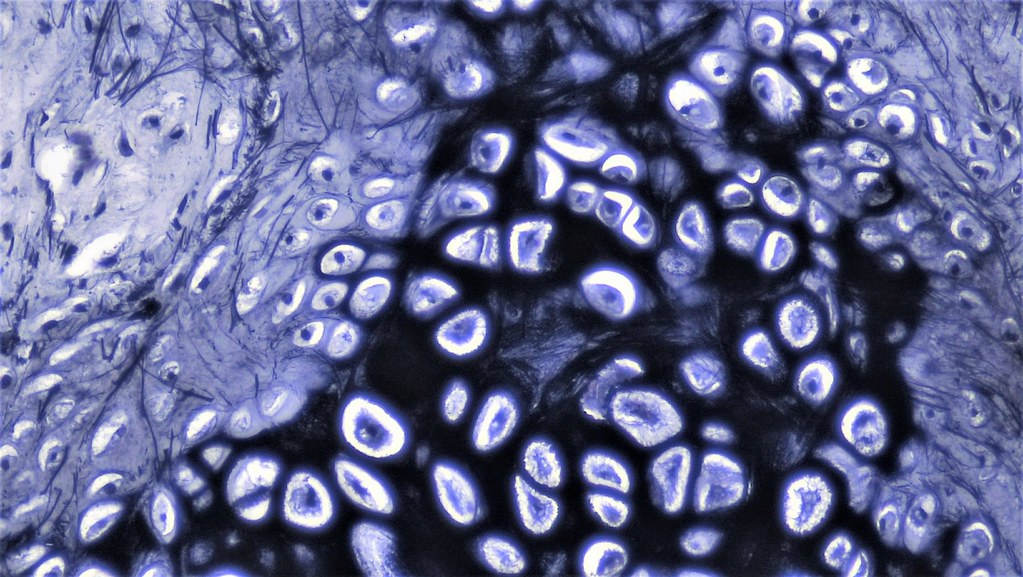Playlist
Show Playlist
Hide Playlist
Cartilage
-
Slides 07 Types of Tissues Meyer.pdf
-
Reference List Histology.pdf
-
Download Lecture Overview
00:01 In this lecture, I am going to talk to you about cartilage. Cartilage is a very specialized connective tissue. And when we go through this lecture, make sure you can understand the following characteristics of cartilage. There are three types of cartilage and those three types of cartilage have differences structurally. And those differences affect the function of those cartilages perform in the body. So you should know those differences and you should also know about the matrix components of cartilage. I covered the basic matrix components in a general lecture on connective tissue earlier. Cartilage has a capsule around it called the perichondrium. And during this lecture, I will explain to you the role it has in enabling cartilage to grow, but has limited capacity for allowing cartilage to repair itself. Finally, we will go through the process of how cartilage does grow. 01:12 When we think about the function of cartilage, then we need to understand that it is designed particularly to bear stresses in the body at joints. But it also forms the skeleton during our fetal development and that skeleton is going to be involved with the growth of bones and I am going to cover the growth of bones in a later lecture. Cartilage also, in certain locations, provides components of body with flexibility and again I will demonstrate the structural components that allow that flexibility. So like we should address when we look at all sorts of tissues, it is very important that we ask the first question and that is what are the characteristics of that tissue or that organ system. So again in this lecture, let us look at the characteristics of cartilage. Well, it is avascular. That means it does not have a direct blood supply. So when you look at a section of cartilage as you see here, you do not see blood capillaries, no arteries and veins. It is avascular. 02:34 So later on we need to ponder and answer the question of how the cartilage cells then get their nutrients. 02:45 Cartilage consists like all connective tissues of cells, fibres and matrix. In the case of cartilage, the matrix is by far the most abundant component. It is also the functional component. 03:01 It is the main part of cartilage that gives cartilage its structural characteristics and its roles in various parts of the body. It is going to be the component of cartilage that changes as we look at the three different types of cartilage that I mentioned earlier on in the lecture. The cell that lives in cartilage is called a chondrocyte. It is derived from mesenchyme, just like all other cells that give rise to connective tissue cells. 03:40 Let us look at the matrix. The matrix is that clear bluish purply tinge you see in the section. 03:50 Have a look also again and identify some of the chondrocytes sitting in this cartilage matrix. The extracellular matrix or the matrix that comprises cartilage is very resilient. 04:07 It has those glycosaminoglycans within the matrix components. And if you recall from my general lecture on connective tissue, those glycosaminoglycans hold a lot of water and therefore the extracellular matrix is very turgid. It is very strong. It can resist compressive forces. The collagen that we see in the matrix of cartilage is type II, generally. But we will also see that in some cartilages, the collagen is predominantly type I, very strong cartilage that requires a very strong collagen component. And again you do not see little capillaries or blood vessels in this image and again I ask you the question think about how chondrocytes can be nourished.
About the Lecture
The lecture Cartilage by Geoffrey Meyer, PhD is from the course Connective Tissue.
Included Quiz Questions
Which of the following statements regarding cartilage in INCORRECT?
- It is vascular.
- It has elastic fibers.
- It has specialized cells called chondrocytes.
- It is rigid.
- It has type 2 collagen fibers.
Which of the following cells is the primary cell type in the cartilage?
- Chondrocyte
- Osteoblasts
- Osteoclasts
- Osteocyte
What is the most abundant component of cartilage?
- Matrix
- Chondrocytes
- Chondroblasts
- Fibroblasts
- Vessels
Customer reviews
5,0 of 5 stars
| 5 Stars |
|
5 |
| 4 Stars |
|
0 |
| 3 Stars |
|
0 |
| 2 Stars |
|
0 |
| 1 Star |
|
0 |




